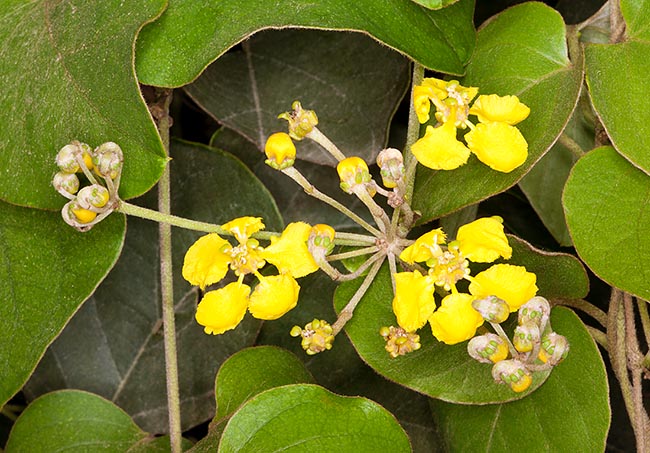Family : Malpighiaceae

Text © Pietro Puccio

English translation by Mario Beltramini

Stigmaphyllon sinuatum is a woody climber of Central America pluvial forests. Poorly known elsewhere © G. Mazza
The species is native to Bolivia, Brazil, Colombia, Ecuador, French Guyana, Guyana, Peru, Suriname and Venezuela where it grows climbing the trees of the pluvial forests, often along the water streams, from the sea level up to about 1000 m of altitude.
The name of the genus is the combination of the Greek substantives “στίγμα” (stigma) = stigma and “φύλλον” (phyllon), with reference to the appendices of the stigmata similar to leaves; the name of the species is the Latin adjective “sinuatus, a, um” = sinuate, sinuous, with reference to the wavy leaves.
The Stigmaphyllon sinuatum (DC.) A.Juss. (1840) is a woody climber rather variable, as per shape of the leaves and the colour of the flowers, which may reach the 30 m of length. The leaves on an 1,3-10 cm long petiole equipped with two circular glands at the apex, are opposite or arranged in verticils of 3, ovate to cordate to elliptic, rarely with 3-5 lobes, obtuse, mucronate, 6-20 cm long and 4-20 cm broad, of dark green colour on the upper page, pale green below. Axillary inflorescences, on 0,3-1 cm long peduncle, carrying numerous (15-35) hermaphroditic flowers reunited in umbels with 5 sepals calyx, 1,5-2,5 cm long and broad, 5 unguiculate petals (petals with long restricted base similar to a stem) of intense yellow colour or variously shaded of red, orbicular with wavy and toothed-ciliate margin, 1,2-1,6 cm long, 10 unequal stamina and three styles ending in a stigma provided of a green leaflet. The fruit is a schizocarp subdividing in three samaras (dried indehiscent fruits having a membranous wing allowing their dispersion by means of the wind) with dorsal wing, 3,5-5,5 cm long and 1-1,5 cm broad, of reddish brown colour.
It reproduces by seed, in organic loam with addition of coarse siliceous sand or agri-perlite per a 30% maintained humid at the temperature of 22-24 °C.
Vigorous species practically unknown outside its origin zones, cultivable in the humid tropical and subtropical climate zones where can be made to climb on robust railings or pergolas, or, as in the wild, on the trees. It requires a full sun exposition or a slight shade and is not particular about the soil, provided the same is well drained, maintained almost constantly humid.
Locally, the flexible and robust stems are utilized as ties.
Synonyms: Banisteria heterophylla Willd. (1799); Banisteria sinuata DC. (1824); Banisteria splendens DC. (1824); Stigmaphyllon fulgens A.Juss. (1840); Stigmaphyllon martianum A. Juss. (1840); Stigmaphyllon richardianum A. Juss. (1840); Stigmaphyllon heterophyllum Hook. (1843); Stigmaphyllon hypoleucum Miq. (1844); Stigmaphyllon purpureum Benth. (1848); Stigmaphyllon brachiatum Planch. & Triana (1862); Stigmaphyllon monancistrum Nied. (1899); Stigmaphyllon splendens (DC.) Cuatrec. (1958).
→ To appreciate the biodiversity within MALPIGHIACEAE family please click here.
